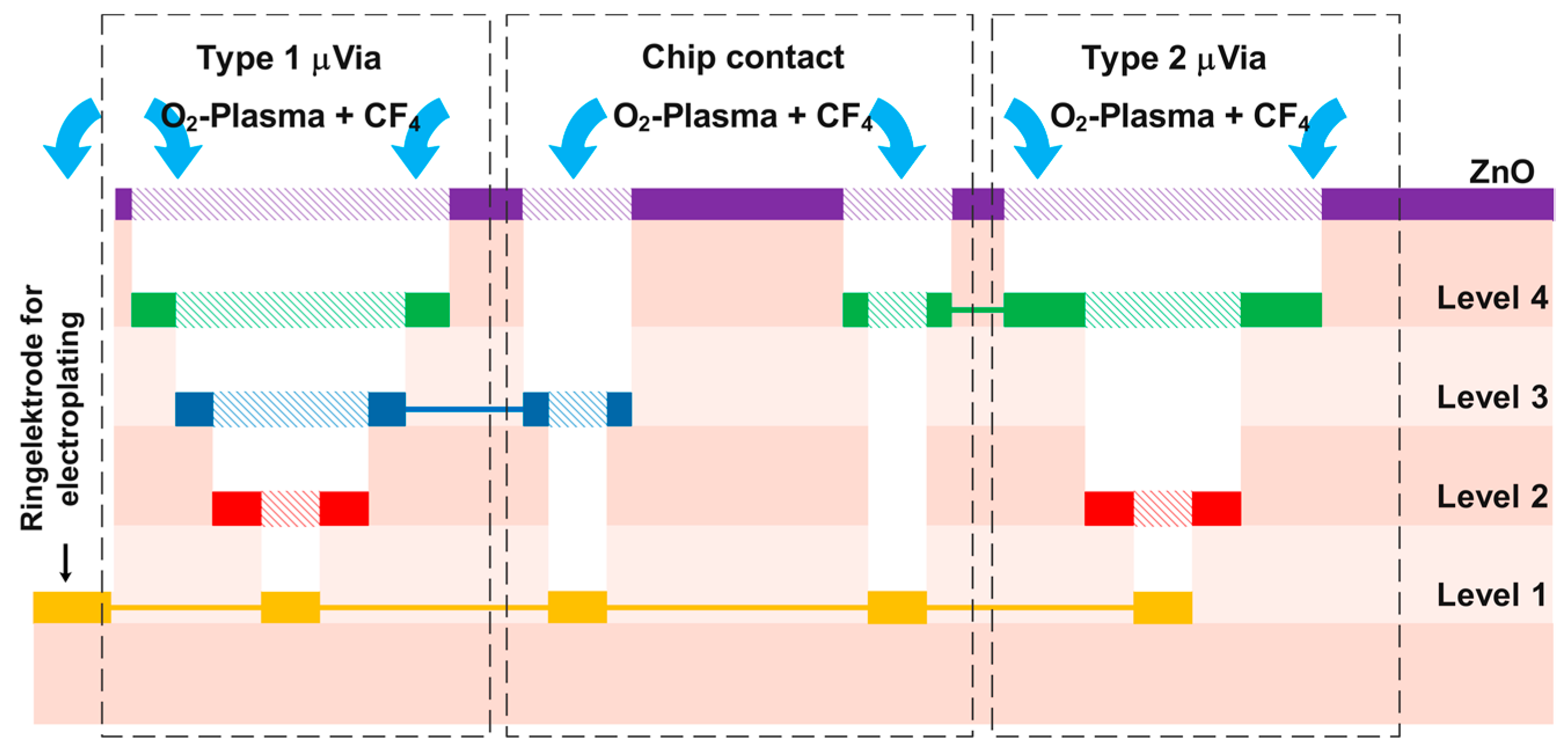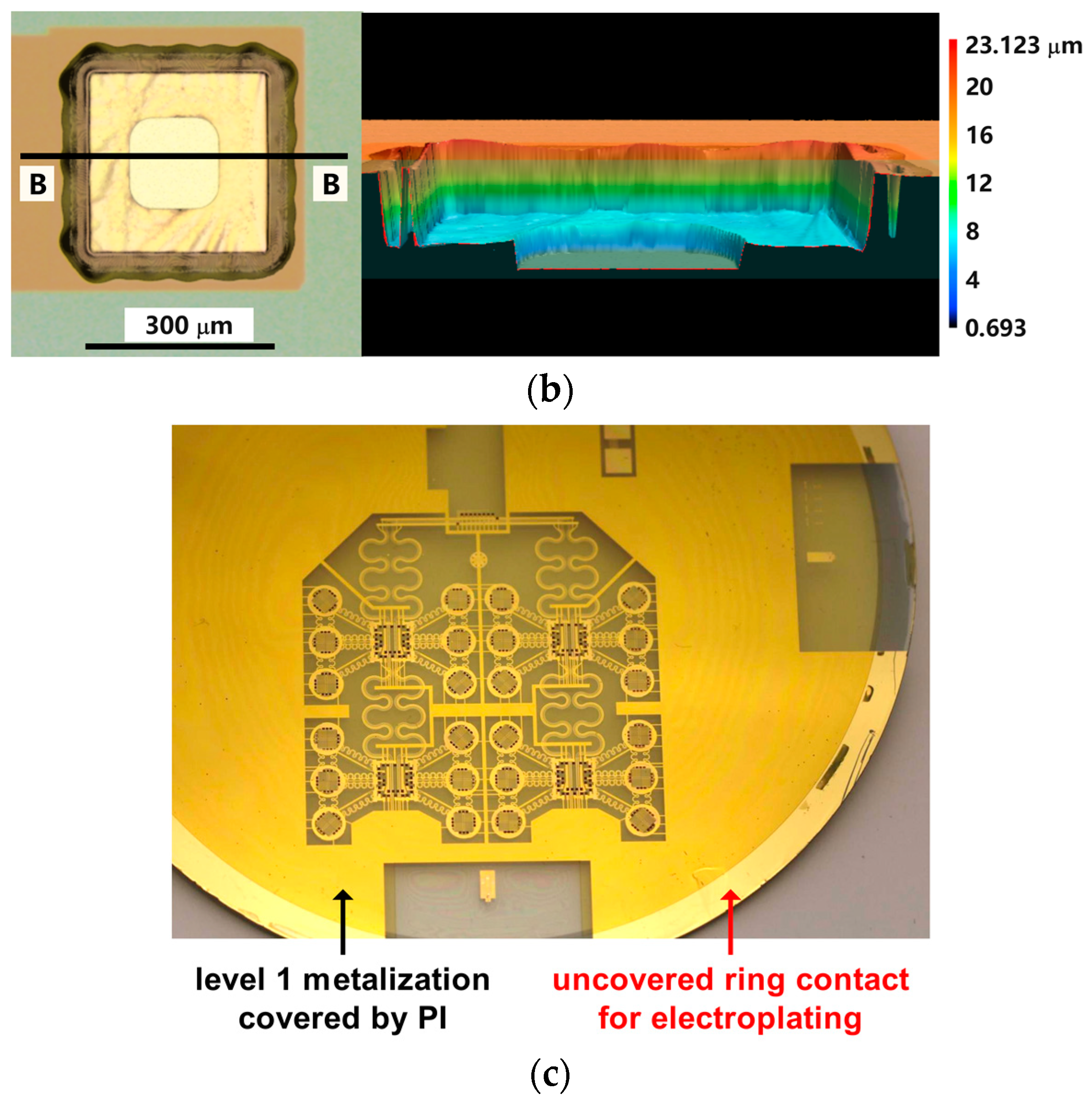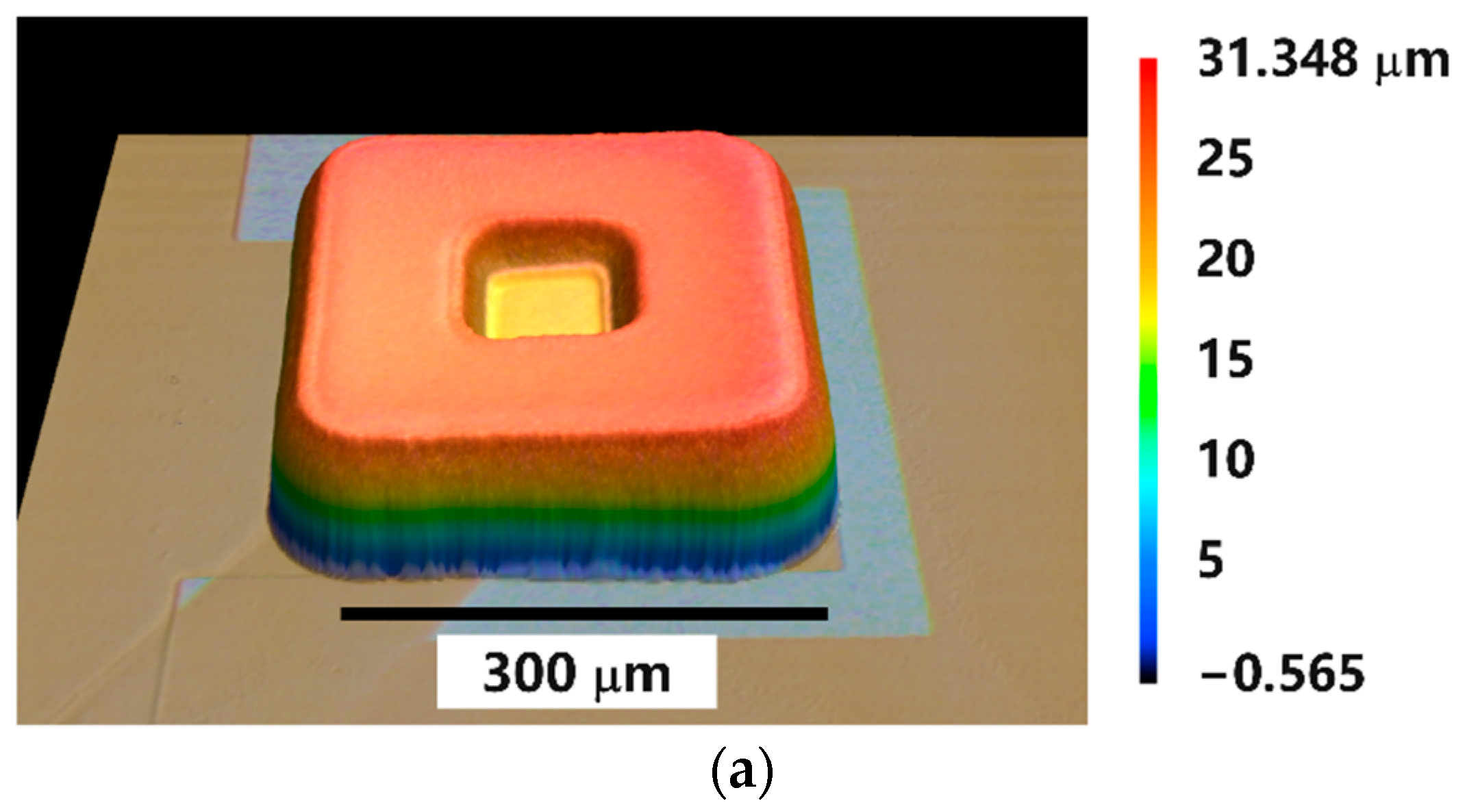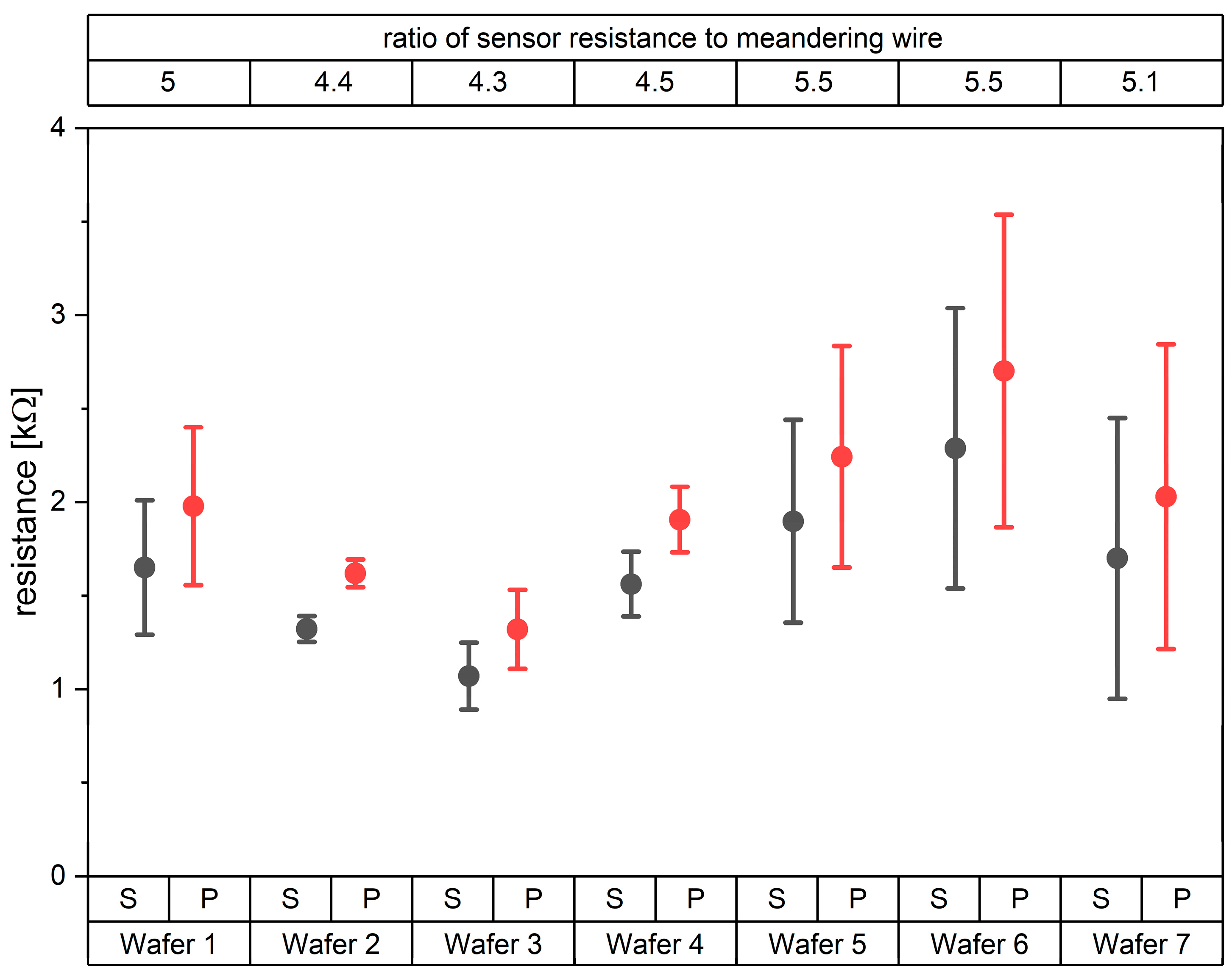Four-Level Micro-Via Technology (4LµV) for ASIC Integration in Active Flexible Sensor Arrays
Abstract
:1. Introduction
2. Design and Fabrication
2.1. Sensor Circuit
2.2. Multilevel Metallisation and Micro-Via Opening
2.3. Copper Electroplating
2.4. Laser Cutting
3. Results and Discussion
4. Conclusions
Author Contributions
Funding
Institutional Review Board Statement
Informed Consent Statement
Data Availability Statement
Acknowledgments
Conflicts of Interest
References
- Park, Y.J.; Sharma, B.K.; Shinde, S.M.; Kim, M.-S.; Jang, B.; Kim, J.-H.; Ahn, J.-H. All MoS2-based large area, skin-attachable active-matrix tactile sensor. ACS Nano 2019, 13, 3023–3030. [Google Scholar] [CrossRef] [PubMed]
- Cheng, M.-Y.; Huang, X.-H.; Ma, C.-W.; Yang, Y.-J. A flexible capacitive tactile sensing array with floating electrodes. J. Micromech. Microeng. 2009, 19, 115001. [Google Scholar] [CrossRef]
- Nakata, S.; Arie, T.; Akita, S.; Takei, K. Wearable, flexible, and multifunctional healthcare device with an ISFET chemical sensor for simultaneous sweat pH and skin temperature monitoring. ACS Sens. 2017, 2, 443–448. [Google Scholar] [CrossRef] [PubMed]
- Feng, R.; Mu, Y.; Zeng, X.; Jia, W.; Liu, Y.; Jiang, X.; Gong, Q.; Hu, Y. A flexible integrated bending strain and pressure sensor system for motion monitoring. Sensors 2021, 21, 3969. [Google Scholar] [CrossRef] [PubMed]
- Shi, C.; Zou, Z.; Lei, Z.; Zhu, P.; Nie, G.; Zhang, W.; Xiao, J. Stretchable, rehealable, recyclable, and reconfigurable integrated strain sensor for joint motion and respiration monitoring. Research 2021, 2021, 9846036. [Google Scholar] [CrossRef] [PubMed]
- Koch, E.; Dietzel, A. Surface reconstruction by means of a flexible sensor array. Sens. Actuators A Phys. 2017, 267, 293–300. [Google Scholar] [CrossRef] [Green Version]
- Koch, E.; Dietzel, A. Skin attachable flexible sensor array for respiratory monitoring. Sens. Actuators A Phys. 2016, 250, 138–144. [Google Scholar] [CrossRef]
- Huang, H.; Wu, N.; Liu, H.; Dong, Y.; Han, L.; Wan, S.; Dou, G.; Sun, L. Directional sweat transport and breathable sandwiched electrodes for electrocardiogram monitoring system. Adv. Mater. Interfaces 2021, 9, 2101602. [Google Scholar] [CrossRef]
- Jeong, Y.R.; Kim, J.; Xie, Z.; Xue, Y.; Won, S.M.; Lee, G.; Jin, S.W.; Hong, S.Y.; Feng, X.; Huang, Y.; et al. A skin-attachable, stretchable integrated system based on liquid GaInSn for wireless human motion monitoring with multi-site sensing capabilities. NPG Asia Mater. 2017, 9, e443. [Google Scholar] [CrossRef] [Green Version]
- Tung, S.; Witherspoon, S.R.; A Roe, L.; Silano, A.; Maynard, D.P.; Ferraro, N. A MEMS-Based Flexible Sensor and Actuator System for Space Inflatable Structures. Smart Mater. Struct. 2001, 10, 1230–1239. [Google Scholar] [CrossRef]
- Schmitt, R.P.; Menk, L.A.; Baca, E.; Bower, J.E.; Romero, J.A.; Jordan, M.B.; Jackson, N.; Hollowell, A.E. Void-free copper electrodeposition in high aspect ratio, full wafer thickness through-silicon vias with endpoint detection. J. Electrochem. Soc. 2020, 167, 162517. [Google Scholar] [CrossRef]
- Andricacos, P.C.; Uzoh, C.; Dukovic, J.O.; Horkans, J.; Deligianni, H. Damascene copper electroplating for chip interconnections. IBM J. Res. Dev. 1998, 42, 567–574. [Google Scholar] [CrossRef]
- Dietzel, A.; van den Brand, J.; Vanfleteren, J.; Christiaens, W.; Bosman, E.; De Baets, J. System-in-foil technology. In Ultra-Thin Chip Technology and Applications; Burghartz, J., Ed.; Springer: New York, NY, USA, 2010; pp. 141–157. [Google Scholar] [CrossRef]
- van den Brand, J.; de Baets, J.; van Mol, T.; Dietzel, A. Systems-in-foil—Devices, fabrication processes and reliability issues. Microelectron. Reliab. 2008, 48, 1123–1128. [Google Scholar] [CrossRef]
- Cauwe, M.; Vandecasteele, B.; de Baets, J.; van den Brand, J.; Kusters, R.; Sridhar, A. A chip embedding solution based on low-cost plastic materials as enabling technology for smart labels. In Proceedings of the 2012 4th Electronic System-Integration Technology Conference, Amsterdam, The Netherlands, 17–20 September 2012; pp. 1–6. [Google Scholar] [CrossRef] [Green Version]
- van den Brand, J.; Saalmink, M.; Barink, M.; Dietzel, A. Novel lamination and interconnection technologies demonstrated in a flexible modular optical sensor array for wound monitoring. Microelectron. Eng. 2010, 87, 769–772. [Google Scholar] [CrossRef]
- van den Brand, J.; Kusters, R.; Barink, M.; Dietzel, A. Flexible embedded circuitry: A novel process for high density, cost effective electronics. Microelectron. Eng. 2010, 87, 1861–1867. [Google Scholar] [CrossRef]
- van den Brand, J.; Kusters, R.; Heeren, M.; van Remoortere, B.; Dietzel, A. Flipchip bonding of ultrahin Si dies onto PEN/PET substrates with low cost circuitry. In Proceedings of the 3rd Electronics System Integration Technology Conference ESTC, Berlin, Germany, 13–16 September 2010; pp. 1–6. [Google Scholar] [CrossRef] [Green Version]
- Schwerter, M.; Hecht, L.; Koch, E.V.; Leester-Schädel, M.; Büttgenbach, S.; Dietzel, A. Liquid polyimide as a substrate for aeronautical sensor systems. In Proceedings of the SPIE Smart Structures and Materials + Nondestructive Evaluation and Health Monitoring, San Diego, CA, USA, 8–12 March 2015; Volume 9435, p. 94352Y. [Google Scholar] [CrossRef]









Publisher’s Note: MDPI stays neutral with regard to jurisdictional claims in published maps and institutional affiliations. |
© 2022 by the authors. Licensee MDPI, Basel, Switzerland. This article is an open access article distributed under the terms and conditions of the Creative Commons Attribution (CC BY) license (https://creativecommons.org/licenses/by/4.0/).
Share and Cite
Zhou, M.; von der Heide, C.; Dietzel, A. Four-Level Micro-Via Technology (4LµV) for ASIC Integration in Active Flexible Sensor Arrays. Sensors 2022, 22, 4723. https://doi.org/10.3390/s22134723
Zhou M, von der Heide C, Dietzel A. Four-Level Micro-Via Technology (4LµV) for ASIC Integration in Active Flexible Sensor Arrays. Sensors. 2022; 22(13):4723. https://doi.org/10.3390/s22134723
Chicago/Turabian StyleZhou, Maolei, Chresten von der Heide, and Andreas Dietzel. 2022. "Four-Level Micro-Via Technology (4LµV) for ASIC Integration in Active Flexible Sensor Arrays" Sensors 22, no. 13: 4723. https://doi.org/10.3390/s22134723
APA StyleZhou, M., von der Heide, C., & Dietzel, A. (2022). Four-Level Micro-Via Technology (4LµV) for ASIC Integration in Active Flexible Sensor Arrays. Sensors, 22(13), 4723. https://doi.org/10.3390/s22134723







